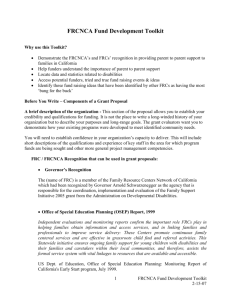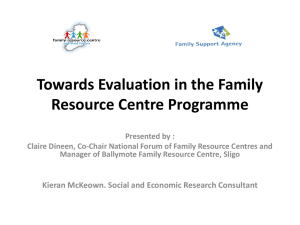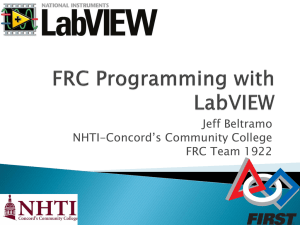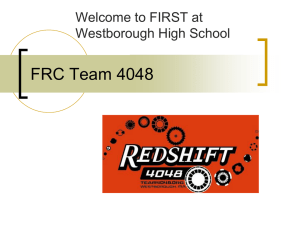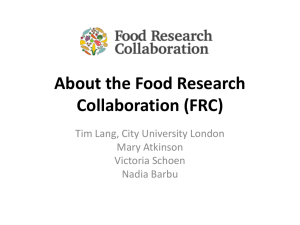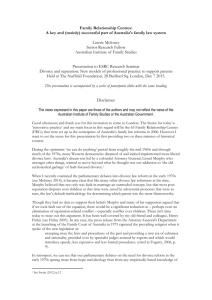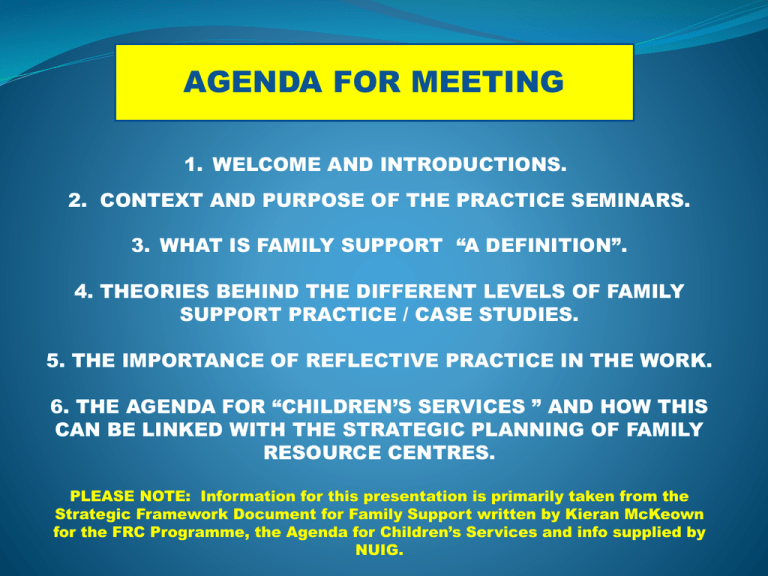
AGENDA FOR MEETING
1. WELCOME AND INTRODUCTIONS.
2. CONTEXT AND PURPOSE OF THE PRACTICE SEMINARS.
3. WHAT IS FAMILY SUPPORT “A DEFINITION”.
4. THEORIES BEHIND THE DIFFERENT LEVELS OF FAMILY
SUPPORT PRACTICE / CASE STUDIES.
5. THE IMPORTANCE OF REFLECTIVE PRACTICE IN THE WORK.
6. THE AGENDA FOR “CHILDREN’S SERVICES ” AND HOW THIS
CAN BE LINKED WITH THE STRATEGIC PLANNING OF FAMILY
RESOURCE CENTRES.
PLEASE NOTE: Information for this presentation is primarily taken from the
Strategic Framework Document for Family Support written by Kieran McKeown
for the FRC Programme, the Agenda for Children’s Services and info supplied by
NUIG.
PURPOSE OF PRACTICE SEMINARS
1. To ensure that all Projects
understand the current developments
and implications of the move under
the Dept. of Children and Youth Affairs.
3. Attempt to develop consistency
across the country in peoples
understanding of Family Support
Practice.
5. An opportunity to share concerns
and understand the various
different levels of Family Support
Practice.
2. Opportunity to engage in a
discussion on the role of the FRC
Programme in Family Support.
4. Give a basic introduction to the
background and theory behind
Family Support Practice and how it
links with Community Development.
6. To develop a programme for future
training, development of policies or
identify additional supports required
by Projects to move through the
transition.
CAN to develop report based on info gathered
at each Seminar and review to take place in
December.
THESE PRACTICE SEMINARS ARE NOT ABOUT
ASKING INDIVIDUIAL PROJECTS TO CHANGE
THE WORK THAT THEY DO.
THEY ARE ABOUT HOW TO
MANAGE IN A CHANGING ENVIRONMENT .
THIS CAN HAPPEN THROUGH UNDERSTANDING
HOW YOUR WORK CAN BE RE-FRAMED TO FIT IN
WITH:
• The language and theory of Family Support
Practice.
•
The Strategic Aims of the Dept. of Children
and Youth Affairs
• The National Children’s Strategy.
RE-CAP ON CURRENT SITUATION / WHERE THE
FRC PROGRAMME IS NOW BASED
Change of Government
brought about the
development of new
Departments
The FSA and Forum
lobbied for the FRC
Programme to come
under the Dept. of
Children and Youth as
this was a safer bet for
maintaining autonomy
The FSA and the National
Forum had to consider how best to help
the FRC Programme survive in this
changing environment
The FRC Programme was to be
placed either in the Dept. of
Community, Environment and
Local Government, where
Cohesion under the Partnership
was inevitable, or into the
Dept. of Children and Youth
Affairs.
In 2010, in readiness for
the change the Forum had
already developed a
Strategy and Position
Paper on promoting the
capacity of FRCs in
supporting families
To make a place for the Programme within the new Department as well as
“PROTECT THE INDEPENDENCE” of Projects the FSA had to take the initiative on:
• Developing and getting adopted the FCRCP’s Strategic Framework Document (Keiron
McKeown) which clarifies the position of Projects in relation to Family Support Practice;
• Develop an external evaluation framework / outcomes focussed (in process);
• Ensure that all Projects understood their role in Family Support Practice.
“WHICH IS WHY THIS PRACTICE SEMINAR IS TAKING PLACE”
PRESENTATION NO 1:
Definition of Family
Support Practice
EXCERCISE
BRAINSTORM…….BY USING THE PENS AND YELLOW
POST-ITS WRITE A SHORT SENTENCE ON WHAT YOU
UNDERSTAND TO BE A DEFINITION OF:
• The Family
• Family Support Practice
ATTACH EACH POST-IT TO THE RELEVANT FLIP CHART
SHEET ATTACHED TO THE WALL
FEEDBACK AND DISCUSSION
A WORKING DEFINITION OF THE FAMILY
This broad definition from the Strategic Framework Document written for FRCs is
based on a wider understanding of the family adopted by the United Nations and the
European Convention of Human Rights……..
A Set of close personal relationships which connect people
together , especially, but not exclusively parents and their
children. These relationships may be based:
•
On social or biological ties;
•
On having / not having formal legal status;
•
In same household or across households;
Examples of families with a range of relationships could be:
•
• Married couples and their children;
• Life partners / cohabitees and their children;
• Parents / guardians and their children;
• Same sex couples and their children;
Siblings or grandparents or extended family members and children.
A DEFINITION OF FAMILY SUPPORT
There are a number of definitions of Family Support, the following was developed by
Pat Dolan of NUIG and used in the FRC National Forum’s Position Paper which is
included in the Strategic Framework Document.
Family Support is both a style of work and set of activities that reinforce
positive informal social networks through integrated programmes;
•
•
These programmes involve statutory, voluntary, community and private
services and are delivered to families in their own homes / communities;
• The focus of these programmes is on early intervention aiming to
protect the health, well being and rights of children, young people and
their families;
•
In particularly those who are vulnerable and at risk due to living in areas
that experience multiple dis-advantage.
The work of FRCs is based on a “HOLISTIC / COMMUNITY
DEVELOPMENT” approach which fits in well with this definition
BACK GROUND TO FAMILY SUPPORT PRACTICE
Just like Community Development, Family
Support Practice has a long history and
includes 24 pieces of national and international legislation that has influenced the
practice.
There are 7 key pieces that relate to the
current circumstances and these are……..
1. 1991 CHILDCARE ACT:
Replaced the 1908 Act. Better for children to grow up in their own families. Onus on HSE to provide a
range of child care and family support services. Welfare of child paramount.
Connected to the setting up of the Community Development Projects (CDPs) in 1991 AND Family
Resource Centres (FRCs) in 1995.
2. 1989 UNITED NATIONS COMMISSION ON RIGHTS OF THE CHILD:
Adopted in Ireland in 1992 / international recognition that children have a right to a range of civil,
economic, cultural and political rights.
3. 1998 REPORT ON COMMISSION OF THE FAMILY:
State policy on Family Support, highlighting the need for preventative and supportive measures for
families which would lead to the setting up of the Family Support Agency in 2003.
4. 1999 & 2011 CHILDRENS FIRST GUIDELINES:
National guidelines for the protection of children / defining family support practice.
5. 2003 FAMILY SUPPORTAGENCY ACT:
Established the FSA and officially separated the FRCs from the CDP Programme and establish the
Family and Community Resource Centre Programme.
6. 2005 SET UP OF NATIONAL CHILDRENS OFFICE:
Improve the lives of children and implement the National Children’s Strategy and coherance in policy,
this has become the Office of the Minister of Children and Youth Affairs where FRC’s are now placed.
7. 2007 THE AGENDA FOR CHILDREN’S SERVICES:
Core principle that the provision of health and social services be based on the child being supported
in the family within the local community.
FAMILY SUPPORT PRACTICE ALSO HAS 10
CORE PRINCIPLES
THESE PRINCIPLES ARE VERY CLEARLY
LINKED TO THE COMMUNITY DEVELOPMENT
PRINCIPLES THAT FRC’S USE IN THEIR DAY
TO DAY WORK
COMMUNITY DEVELOPMENT
PRACTICE
Collective Action &
Working in partnership
Participation
Equality, discrimination
and Social Inclusion
FAMILY SUPPORT PRACTICE
PRINCIPLES
1. Working in Partnership / holistic
approach.
2. Promotes the view that effective
interventions are those that strengthen
informal support networks.
3. Families can self refer / multiaccess referral paths can be created.
4. Services aim to promote social inclusion
addressing issues of ethnicity, disability,
urban & rural etc.
Empowerment / human
rights based approaches
5. Clear focus on the wishes, feelings, safety
and well being of children.
6. Needs led and strives for the minimum
intervention.
7. Family Support Services reflects strength
based perspective of families and children.
Process and the task
8. Involvement of service users and providers
in planning, delivery and evaluation.
9. Family Support creates an accessible and
flexible environment based on needs.
Social change and
influencing policy
10. Measures success through evaluation based
on outcomes for service users, this supports
the development of effective services.
ANY ADDITIONAL
COMMENTS OR QUESTIONS
PRESENTATION NO 2:
Theory behind the different
levels of Family Support
Case Studies
THERE ARE 5 KEY THEORIES UNDERPINNING INFORMAL
FAMILY SUPPORT
SOCIAL
SUPPORT
ATTACHMENT
Primary relationships in
early childhood
development
SOCIAL
ECOLOGY
Families do not
exist in a vacuum
but in a community
/ neighbourhood
Core functions of
the family
CHILDREN
AND
FAMILY
Stress and strain
RESILIENCE
Cope and adapt
SOCIAL
CAPITAL
Builds on
capacity / acts
as a resource
ALSO INFORMED BY:
•
Social Justice and Children’s rights
(Human and Family Rights perspective)
• Reflective Practice
• Evidence base
• Best practice
• Focus on outcomes
THEORY OF SOCIAL ECOLOGY / ECOLOGICAL
PERSPECTIVE
HIGHLIGHTS…….
• The need to look beyond the family system;
• The importance of context on the health and well
being of children and families;
• Individual, family and wider community need
collective consideration;
• Examining these factors in isolation is not
sufficient .
THERE ARE FOUR ECOLOGICAL SYSTEMS
FRAMEWORK……..
THESE ARE DIFFERENT LAYERS OF SYSTEMS THAT
INTERACT WITH EACH OTHER
(LIKE RUSSION DOLLS)
Micro (minute)
Meso (intermediate)
Exo (outside)
Macro (large)
THEORY OF SOCIAL SUPPORT
The definitions are all based on assumptions that people
rely on each other for basic needs;
Social support can be defined as “behaviours that assist
persons that are undergoing stressful life circumstances
to cope with the circumstances they face” ;
“Responsive acts of assists between human beings”
Automatically assumed by most people;
Proven area of Social Science;
Enhancing social support is the aim of formal support
services;
TYPES OF
SUPPORT:
QUALITIES OF
SUPPORT
• Concrete
• Durability
• Emotional
• Reciprocity
• Advice
• Closeness
• Esteem
• Admonishment
INFORMAL, SEMI-FORMAL AND FORMAL SOURCES
PERCIEVED AND RECEIVED SUPPORT
TYPES OF SOCIAL SUPPORT……..
CONCRETE & PRACTICAL:
Where an offer to do or to
provide is proffered.
EMOTIONAL:
Where concern and empathy are
offered.
INFORMATION & ADVICE:
Where suggestions and advice
are offered.
ESTEEM:
Where encouragement and
belief in the recipient is
provided.
THEORY OF SOCIAL CAPITAL
REFERS TO…..
The assets of daily living including good will between
people;
The more embedded a family is across the levels of the
eco-system the greater will be their social capital;
Accruing of benefits and capital from involvement with
networks or other social structures;
Social connections between people – based on principles
of shared norms, trust and reciprocity.
FORMS OF SOCIAL CAPITOL ARE…….
PHYSICAL
HUMAN &
CULTURAL
ECONOMIC
SOCIAL
Linked to wider social networks and local informal / formal
networks such as:
Family; extended family; community and voluntary groups;
clubs; work place; child minders; political parties; classmates
etc..
FEATURES OF SOCIAL CAPITAL…….
BONDING SOCIAL CAPITAL:
Close ties and strong
local trust “Getting by”
BRIDGING SOCIAL CAPITAL:
Weak ties with people
who are not close
“Getting ahead”
Community based Family Support Aims
to build up
BONDING SOCIAL CAPITAL
through local supportive networks.
THEORY OF ATTACHMENT
Forming a close attachmens to a care giver is
the most important early social relationship.
Attachment Theory involves the study of early
formative relationships and how these are key
to the infant in forming attachments;
The quality of these attachments informs
emotional health and personal development.
ATTACHMENT HELPS A CHILD TO………
• Attain full intellectual potential, sort out what
he / she perceives;
• Think logically;
• Develop conscience;
• Become self reliant;
• Cope with stress and frustration;
• Handle fear and worry;
• Develop future relationships and reduce
jealousy.
MOST IMPORTANTLY ATTACHMENT THEORY
PROVIDES AND UNDERSTANDING OF……….
Why those who have suffered adverse
relationships in the past go onto find
relationships difficult in the future, with
parents, peers, partners, children,
neighbours and figures of authority.
THEORY OF RESILIANCE
RESILIANCE . . . . is a persons ability to withstand
stress and to be positive, optomistic and stronger as a
result of life experiences whether positive or negative.
There are three factors associated with resiliance
which include:
• Self esteem and confidence;
• A belief in ones own ability to deal with change and
adaptation;
• Repertoire of problem solving skills.
FACTORS WHICH HELP A PERSON TO BECOME
RESILIENT ARE. . . .
• Competent parenting (good enough);
• Availability of a close social support network;
• A positive educational experience;
• A sense of worth;
• Good relationships with pro-social adults and an
ability to problem solve and make sense of what is
happening.
RISK FACTORS INCLUDE ISSUES SUCH AS . . .
Poverty; poor educational opportunity; lack of access
to interests / hobbies or leisure and poor parenting
including potential of actual harm or abuse.
WHAT HELPS FACILITATE RESILIANCE. . .
The impact of the community on well being and
resilience has been the subject of a wide range
of research which indicates that:
• Communities have the capacity to improve
local well being and to be considered
resilient in themselves as actors responding
to adversity;
• Emphasis has been placed on the positive
and beneficial outcomes from community
participation with a strong association with
civic engagement.
SOCIAL JUSTICE AND CHILDRENS RIGHTS
Families have a right to be supported in their efforts and
children have a right to be supported within their family unit.
The issue of social justice and children’s rights are considered
collectively.
UNCRC, 1989
The guiding principles of the Convention as set out in the
NATIONAL CHILDREN’S STRATEGY are:
• All children should be entitled to basic rights without
discrimination;
• The best interests of the child should be the primary
concern of decision making;
• Children should have a right to life, survival and development;
• The views of children must be taken into account in matters
effecting them.
SOCIAL JUSTICE AND CHILDREN’S RIGHTS
• Children’s rights and needs are inherently
intertwined;
• Rights discourse can provide an important
framework to discuss needs while addressing
ideas of self respect and dignity;
• Linking rights to needs ~ children’s rights are
grounded in the day to day practice of
service delivery, and offer a benchmark from
which to plan, deliver and evaluate services.
A FRAMEWORK FOR
THE DELIVERY OF
FAMILY SUPPORT
Framework for Support Services (HARDIKER 1991)
In need of specialist
care
LEVEL 4
Established difficulties
and serious risk
LEVEL 3
Targeted services
Those with early difficulties and risk
LEVEL 2
All children and young people
Universally available services
LEVEL 1
CATAGORIES OF SUPPORT LINKED TO THE
STRATEGIC FRAMEWORK DOCUMENT
CATAGORIES
PROTECTIVE
COMPENSATORY
DEVELOPMENTAL
LEVELS OF NEED
LEVEL 4:
Supports and rehabilitation for children
and families with established difficulties
and at serious risk
LEVEL 3:
Services for children and families
targeting early difficulties and at
significant risk
LEVEL 2:
Support for children and families in
need.
LEVEL 1:
Universally available services
SMALL GROUP DISCUSSION
You will be given a case study for
each small group.
You are being asked to consider the
level of intervention that is required.
FEEDBACK / DISCUSSION
LUNCH
PRESENTATION NO 3
The importance of
Reflective Practice
in the work
WHY TAKE THE TIME TO REFLECT ON
PRACTICE
1. Gives staff time to reflect on stresses and demands
of the work.
2. Creates a supportive and safe environment in which to
develop practice.
3. Sharing of ideas, solutions and possibilities for
resolving problems.
4. Builds the confidence and skills of staff.
5. Highlights problems arising in the work, opportunity to explore
referral to other services that may need to be brought in.
6. Ensures and facilitates accountability / protects staff.
7. Can be undertaken on a one to one basis or in staff
team meetings.
WHAT ARE WE REFLECTING ON…..
PERSON OR FAMILY IN NEED / THE ISSUES PRESENTED
What you know
(The theory)
What you do
(The skills & practice)
How you do it
(The attitude and values)
NEEDS MET / OUTCOMES ACHIEVED
LOOK AT CASE STUDIES AGAIN AND
DISCUSS:
What was the knowledge / theory
required by the staff member to deal
with the issue ?
What skills / practice were used and
what were the actions implemented ?
What was the attitude / values of the
staff member ?
(Feedback)
( INFORMATION FROM KIERION McKEOWN’S STRATEGIC FRAMEWORK FOR FAMILY SUPPORT )
KNOWLEDGE /
THEORY
SKILLS /
PRACTICE
• Definition of the family and
why families are important;
• How to work effectively as
a team;
• What influences family well
being and the different levels
of family support;
• How to link needs, actions
and outcomes into logic
framework (Workplans);
• Essence of a helping
relationship and how to
operate from a community
development approach;
• Needs of families in the area;
• What outcomes the FRC is
trying to achieve;
• What actions and programmes
will help reach those
outcomes;
• How to undertake strategic
planning, evaluation and
monitoring;
• Any legal issues / policies
required.
• How to facilitate local
peoples involvement in
developing the strategy
(consultation);
• How to communicate well
and build commitment for
implementing the
Workplan;
• Prioritising and setting
realistic time frames;
• How to engage and work
with external agencies.
ATTITUDES /
VALUES
• Clear self awareness of
thoughts, feelings and
prejudices;
• Empathetic understanding;
• Commitment to diversity,
equality and human rights;
• Respecting boundaries;
• Acting in a way that is
positive, practical,
pragmatic and has the best
outcomes;
• Develop an empowering
process that leads to
positive outcomes;
• Openness to working in
collaboration with others;
• Taking responsibility for
learning through reflective
practice.
POSSIBLE QUESTIONS THAT CAN BE USED IN
SUPERVISION OR TEAM MEETINGS THAT RELATE
TO FAMILY SUPPORT PRACTICE
What are your strengths in terms of working with individuals, families and
communities ? What do you see as your weaknesses or areas for growth;
•
•
What do you bring to your role in supporting individuals, families and the
community from your training / life experience. How do these
• help / hinder you in your work;
•
What does this work mean to you personally, what are the things about it
that you connect to meaningfully;
•
•
•
What are the aspects that challenge you, or worry you in the work;
How do you deal with stresses or challenges that arise in supporting
individuals, families or the community;
What do you need in your role to do the best work you can do, and to grow
in your role, how can supervision meet some of these needs;
BRIEF OPEN DISCUSSION
Is this the same or different in terms of the
a). Knowledge, skills and values that you already
work from, and
b). The reflective practice you do
If so, what do you notice are the similarities and
differences ?
PLEASE NOTE:
Future external evaluation systems currently being developed by Kieron
McKeown may define how we carry out reflective practice as this will be
more outcomes based.
Also, more info on reflective practice also in the Agenda for Childrens
Services
PRESENTATION NO 4
Being aware of and
developing links with the
Agenda for Children’s
Services
WHY SHOULD WE ?
The Childrens’s Services Strategy is now under the care of the Department of
Children and Youth Affairs and has huge influence. This is the same Department
that the Community and Family Resource Centre Programme has moved to.
The Agenda for Children’s Services is to develop a
WHOLE CHILD / WHOLE SYSTEM APPROACH
to promoting better outcomes for children through co-operative
and collaborative working relationships and services.
FRCs have a role to play in this.
BETTER OUTCOMES FOR CHILDREN
Enhancing the status and improving the quality
of children’s lives by building
strong and healthy families and communities
through the process of….
PREVENTION
EARLY
INTERVENTION
COMMUNITY
SERVICE
PROVISION
OUT-OF-HOME
CARE
PROTECTION
THR AGENDA FOR CHILDRENS SERVICES HAS A POLICY
DOCUMENT WHICH OUTLINES THE FOLLOWING:
1. AIMS AND OBJECTIVE
2. PROMOTING GOOD OUTCOMES FOR CHILDREN AND YOUNG PEOPLE
3. SERVICE CHARACTARISTICS NEEDED TO ACHIEVE GOOD
OUTCOMES INCLUDING:
3.1 Connecting Services with family and Community Strengths;
3.2 Ensuring quality services;
3.3 Opening access to services;
3.4 Delivering integrated services;
3.5 Planning, monitoring and evaluating Services.
4. GETTING THERE TOGETHER
4.1 Circles of responsibility;
4.2 Shared style of working
Connects with reflective practice
Document can be downloaded from www.omc.gov.ie
THERE ARE 7 NATIONAL OUTCOMES IN THE STRATEGY FOR
CHILDRENS SERVICES
(To be reduced to 5)
1. HEALTHY BOTH PHYSICALLY AND MENTALLY;
2. SUPPORTED IN ACTIVE LEARNING;
3. SAFE FROM ACCIDENTAL OR INTENTIONAL HARM;
4. ECONOMICALLY SECURE;
5. SECURE IN TH EIMMEDIATE AND WIDER PHYSICAL ENVIRONMENT;
6. PART OF POSITIVE NETWORKS OF FAMILY, FRIENDS, NEIGHBOURS AND THE
COMMUNITY;
7. INCLUDED AND PARTICIPATING IN SOCIETY.
DEVELOPMENTAL ACTIVITIES
Are fexible, needs based,
provides support at individual or
community level and supports
positive community involvement
helping children and parents to
feel more attached to the area.
TWO
CATAGORIES
OF ACTIONS
PROGAMME ACTIVITIES
Establishing activities that are
believed to be helpful to those
who participate. Usually
targeted at groups / individuals
and are evidence based.
5 CHARACTERISTS NEEDED TO ACHIEVE
GOOD OUTCOMES
IN ORDER TO PROMOTE THE 7 NATIONAL OUTCOMES FOR
CHILDREN, SERVICES NEED TO STRIVE TO ACHIEVE 5
“ESSENTIAL CHARACHTERSISTICS”
THESE ARE:
1.
Connecting with family and community strengths.
(Directly related to building connections with FRCs)
2. Ensuring quality of service.
3. Opening access to services.
(Potential to deliver Services through FRCs)
4. Delivering integrated services.
(Again promotes the idea of working together WITH FRCs)
5. Planning, monitoring and evaluating services.
(Connects in with external evaluation that will be developed between
Kieran McKeown and FRCs)
IT WOULD THEREFORE BE STRATEGIC IF FRCs , WHILST
MAINTAINING THEIR INDIVIDUAL AIMS AND WORK, BEGAN THE
PROCESS OF LINKING THEIR STRATEGIC AIMS TO THE
RELEVANT 7 OUTCOMES OF THE NATIONAL CHILDRENS
STRATEGY.
THIS CAN HAPPEN THROUGH THE DEVELOPMENT OF NEW
WORKPLANS AND WITH THE SUPPORT OF THE RSA.
AS THE NEW DEPARTMENT DEVELOPS AND IT COMES TO
DECIDING THE ROLE AND APPROPRIATE PLACE OF FRCs IN THE
FAMILY SUPPORT WITHIN THE NEW DEPARTMENT:
• FRCs will be familiar with the background, ethos and language
of current family support practice;
• Be clear about the levels of family support that they can offer;
• Be prepared for possible changes that may come down the line.
ANY QUESTIONS / CLARIFICATIONS
Key web site addresses and documents to read:
STRATEGIC FRAMEWORK FOR FAMILY SUPPORT
BY KIERON McKEOWN
www.fsa.ie
THE AGENDA FOR CHILDRENS SERVICES / A POLICY
HANDBOOK
www.omc.gov.ie
FILL IN EVALUATION SHEET
From your participation today….
1. What is one thing that has changed in your
understanding of Family Support Practice ?
2. What are this issues / concerns that this
raises for you or your Project ?
3. What are the future support needs for you or
your Project in the area of Family Support
Practice ?
CLOSING COMMENTS

